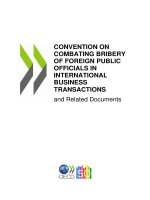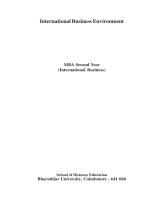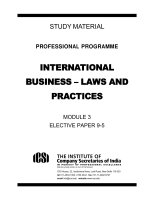International business environment and operations 13e pearson chapter 02
Bạn đang xem bản rút gọn của tài liệu. Xem và tải ngay bản đầy đủ của tài liệu tại đây (332.2 KB, 30 trang )
International Business
Environments and Operations,
13/e
Part Two
Comparative Environmental
Frameworks
2-1
Copyright © 2011 Pearson Education, Inc. publishing as Prentice Hall
Chapter Two
The Cultural
Environments
Facing Business
2-2
Copyright © 2011 Pearson Education, Inc. publishing as Prentice Hall
Chapter Objectives
• To understand methods for learning about
cultural environments
• To analyze the major causes of cultural
difference and change
• To discuss behavioral factors influencing
countries’ business practices
• To understand cultural guidelines for
companies that operate internationally
2-3
Copyright © 2011 Pearson Education, Inc. publishing as Prentice Hall
Culture
Learned norms based on values,
attitudes, and beliefs of a group of
people
2-4
Copyright © 2011 Pearson Education, Inc. publishing as Prentice Hall
Cultural Diversity
A means of gaining global
competitive advantage by
bringing together people of
diverse backgrounds and
experience
2-5
Copyright © 2011 Pearson Education, Inc. publishing as Prentice Hall
Cultural Collision
• Occurs in international business when:
A company implements practices that are less
effective
Employees encounter distress because of
difficulty in accepting or adjusting to foreign
behaviors
2-6
Copyright © 2011 Pearson Education, Inc. publishing as Prentice Hall
Cultural Factors Affecting International
Business Operations
2-7
Copyright © 2011 Pearson Education, Inc. publishing as Prentice Hall
Cultural Awareness
• Problem areas that can hinder managers’
cultural awareness…
Subconscious reactions to circumstances
The assumption that all societal subgroups
are similar
2-8
Copyright © 2011 Pearson Education, Inc. publishing as Prentice Hall
The Idea of a “Nation” – Delineating
Cultures
The nation is a useful definition of society
because:
• Similarity among people is a cause and an
effect of national boundaries
• Laws apply primarily along national lines
2-9
Copyright © 2011 Pearson Education, Inc. publishing as Prentice Hall
The Nation as a Cultural Mediator
• A national culture must be flexible enough
to accommodate the diversity of various
subcultures, ethnic groups, races, and
classes
• Yet every nation boasts certain human,
demographic, and behavioral
characteristics that constitute its national
identity
2-10
Copyright © 2011 Pearson Education, Inc. publishing as Prentice Hall
Country-By-Country Analysis
• Managers find this difficult to implement
because:
Subcultures exist within nations
Similarities link groups from different countries
2-11
Copyright © 2011 Pearson Education, Inc. publishing as Prentice Hall
How Cultures Form and Change
• Change by Choice
Reaction to social and economic situations
• Change by Imposition
Imposed introduction into a culture of certain
elements from an alien culture
2-12
Copyright © 2011 Pearson Education, Inc. publishing as Prentice Hall
Language as Both a Diffuser and
Stabilizer of Culture
A common language within a
country is a unifying force
2-13
Copyright © 2011 Pearson Education, Inc. publishing as Prentice Hall
Major Language Groups: Population and
Output
2-14
Copyright © 2011 Pearson Education, Inc. publishing as Prentice Hall
Religion As A Cultural Stabilizer
Centuries of profound religious
influence continue to play a
major
role in shaping cultural values
and behavior
2-15
Copyright © 2011 Pearson Education, Inc. publishing as Prentice Hall
Behavioral Practices Affecting Business
• Issues in Social Stratification
Social ranking is determined by:
• Factors pertaining to you as an individual
• Factors pertaining to your affiliation with
certain groups
2-16
Copyright © 2011 Pearson Education, Inc. publishing as Prentice Hall
Group Affiliations Can Be:
• Ascribed or Acquired
Include those based on gender, family, age,
caste, ethnic, racial, or national origin
• A reflection of class and status
Include those based on religion, political
affiliation, and professional and other
associations
2-17
Copyright © 2011 Pearson Education, Inc. publishing as Prentice Hall
Social Stratification and Employment
Practices
•
•
•
•
•
Performance Orientation
Open and Closed Societies
Gender-Based Groups
Age-Based Groups
Family-Based Groups
2-18
Copyright © 2011 Pearson Education, Inc. publishing as Prentice Hall
Work Motivation
• Materialism and Motivation
• Expectation of Success and Reward
• Performance and Achievement: The
Masculinity-Femininity Index
• Hierarchies of Needs
2-19
Copyright © 2011 Pearson Education, Inc. publishing as Prentice Hall
Hierarchy of Needs
2-20
Copyright © 2011 Pearson Education, Inc. publishing as Prentice Hall
Relationship Preferences
• Power Distance
• Individualism Versus Collectivism
2-21
Copyright © 2011 Pearson Education, Inc. publishing as Prentice Hall
Risk-Taking Behavior
•
•
•
•
Uncertainty Avoidance
Trust
Future Orientation
Fatalism
2-22
Copyright © 2011 Pearson Education, Inc. publishing as Prentice Hall
Information and Task Processing
• Perception of Cues
• Obtaining Information: Low Context versus
High Context Cultures
• Information Processing
• Monochronic Versus Polychronic Cultures
• Idealism Versus Pragmatism
2-23
Copyright © 2011 Pearson Education, Inc. publishing as Prentice Hall
Communication
•
•
•
•
•
•
Spoken and Written Language
Silent Language
Distance
Time and Punctuality
Body Language
Prestige
2-24
Copyright © 2011 Pearson Education, Inc. publishing as Prentice Hall
Body Language Is Not A Universal
Language
2-25
Copyright © 2011 Pearson Education, Inc. publishing as Prentice Hall









